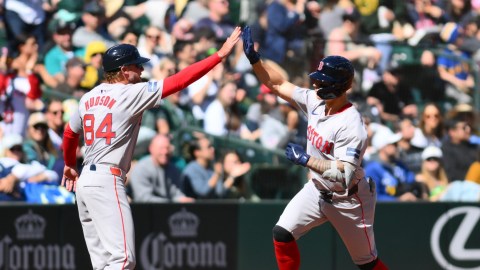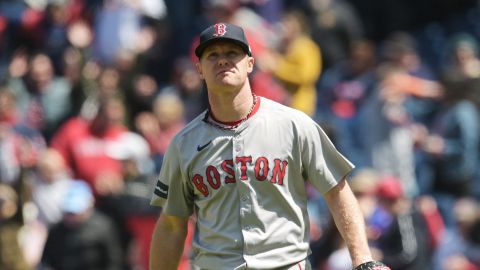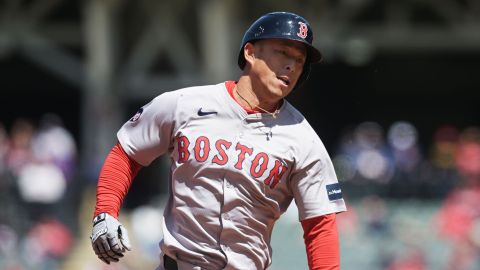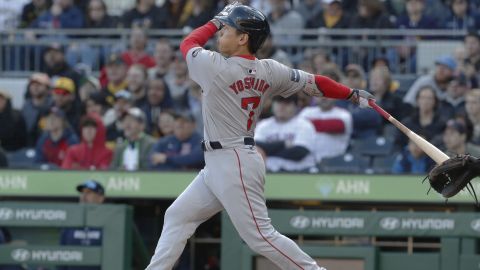 The Boston Red Sox’s world has been shaken up a bit.
The Boston Red Sox’s world has been shaken up a bit.
The Red Sox sat idly this week as the Atlanta Braves traded outfielder Jason Heyward to the St. Louis Cardinals and the Miami Marlins signed outfielder Giancarlo Stanton to a 13-year, $325 million contract. Both moves have implications for Boston.
From a Red Sox standpoint, the most obvious side effect of Stanton signing the largest contract in Major League Baseball history is that the deal all but squashes the pipe dream of the coveted slugger landing in Boston — at least in the short term. Stanton’s deal reportedly includes an opt-out clause after the 2019 season, meaning he could test the open market and Boston could join the fray, but it appears the two-time All-Star will remain in South Beach for at least the next five seasons.
Then again, who knows? The Marlins, after all, have opened the checkbook before, only to then reverse course the following offseason. Who’s to say they won’t dangle Stanton in the coming years if they’re unable to surround him with a winning team?
But let’s assume Stanton stays put. The Red Sox — long considered a potential suitor for Stanton if the Marlins made him available via trade — now have a surplus of prospects they can use to target other players.
This doesn’t mean Boston suddenly will empty the farm, but there’s been a belief that the Red Sox were stockpiling prospects in the hopes of someday making an aggressive push for Stanton. Now that Stanton is unlikely to hit the trade market anytime soon, the Sox can explore Plans B, C, D, etc., without reservations.
Does this mean the Red Sox will more aggressively pursue pitchers Cole Hamels, Johnny Cueto and/or Chris Sale this offseason?
Does it mean the Red Sox will value outfielder Yoenis Cespedes’ power more knowing that Stanton is locked up, ultimately resulting in talks regarding a contract extension?
Only the Red Sox’s front office knows the answers. But Stanton signing a monstrous deal two years away from hitting free agency certainly adds a wrinkle that wasn’t present two weeks ago.
Heyward, meanwhile, was an intriguing backup plan to Stanton despite the Red Sox’s crowded outfield. He’s a left-handed hitter, he’s only 25 and he’s an elite defensive right fielder. The right-handed-heavy Red Sox desperately need a left-handed bat, and Heyward’s defense would have been especially valuable at Fenway Park, where right field can be extremely treacherous because of its unique dimensions. Now, if Heyward ever dons a Sox uniform, it likely won’t be until at least next offseason, when the former first-round pick is eligible for free agency.
The Red Sox reportedly never engaged in trade talks with the Braves for Heyward. The real impact of Monday’s trade thus is felt through the domino effect it has on the market for outfielders.
The Red Sox’s outfield mix currently includes Cespedes, Rusney Castillo, Mookie Betts, Shane Victorino, Allen Craig, Daniel Nava, Jackie Bradley Jr. and Brock Holt. Boston could look to deal from this inventory to obtain pitching.
The significance of the Heyward trade is twofold in that the Cardinals no longer seem like a viable dance partner for the Red Sox while the Braves no longer seem like a competing source of outfielders, though there’s been chatter Atlanta still could deal Justin Upton or Evan Gattis. (This reality doesn’t even take into account Boston’s young starting pitchers, who might be even more in demand now that St. Louis has traded cost-controlled pitching to land Heyward.)
The Heyward trade actually could benefit the Red Sox because teams previously eyeing the two-time Gold Glove winner might now turn their attention to Boston’s outfield, opening up trade possibilities that otherwise wouldn’t have existed. Cespedes is the Red Sox outfielder most commonly mentioned in trade speculation because of his age, power and proximity to free agency (he’s slated to hit the open market next offseason). His value might have just increased to some extent, even with the Cardinals coming off the board as a potential suitor.
Boston might choose to skate its lane, opting to improve its roster through free agency rather than trades. If the Red Sox dip into the trade waters, though, they’ll likely discover a market that’s somewhat different than it was at the beginning of the offseason.
Jason Heyward photo via Jason Getz/USA TODAY Sports Images. Giancarlo Stanton photo via Charles LeClaire/USA TODAY Sports Images.




